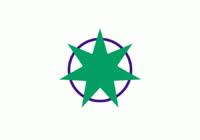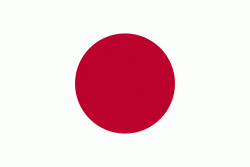Aomori (Aomori Shi)
 |
Aomori literally means blue forest, although it could possibly be translated as "green forest". The name is generally considered to refer to a small forest on a hill which existed near the town. This forest was often used by fishermen as a landmark. A different theory suggests the name might have been derived from the Ainu language.
The area has been settled extensively since prehistoric times, and numerous Jōmon period sites have been found by archaeologists, the most famous being the Sannai-Maruyama Site located just southwest of the city center dating to 5500–4000 BC, and the Komakino Site slightly farther south dating to around 4000 BC. The large scale of these settlements revolutionized theories on Jōmon period civilization. During the Heian period, the area was part of the holdings of the Northern Fujiwara clan, but remained inhabited by the Emishi people well into the historic period. After the fall of the Northern Fujiwara in the Kamakura period, the territory was part of the domain assigned to the Nambu clan, and into the Sengoku period, it came under the control of the rival Tsugaru clan, whose main castle was located in Namioka. After the start of the Edo period, what would become the core of present-day Aomori was a minor port settlement in the Hirosaki Domain called Utō (善知鳥村). The town was rebuilt in 1626 under orders of the daimyō, Tsugaru Nobuhira and renamed "Aomori", but this name did not come into common use until after 1783; however, the historical accuracy of this claim is debated since there is no written material from the time to definitively connect Utō to Aomori. Some evidence even claims that Aomori and Utō co-existed in different parts the city in its current state. It was not until 1909 that a local scholar claimed that the village of Utō became Aomori.
After the Meiji Restoration, the feudal domains were abolished and replaced with prefectures, of which a total of six were initially created in the territory of modern Aomori Prefecture. These were merged into the short-lived Hirosaki Prefecture in July 1871. However, due to the historic enmity between the former Tsugaru territories in the west and the former Nambu territories in the east, the prefectural capital was relocated from Hirosaki to the more centrally-located Aomori immediately after the merger and the prefecture was renamed Aomori Prefecture on 23 September 1871. However, the municipality of Aomori was not given town status within Higashitsugaru District until 1 April 1889, with the establishment of the modern municipalities system. It was later designated as a city on 1 April 1898.
The Hokkaidō Colonization Office began operations of a ferry service from Aomori to Hakodate in Hokkaido from 1872. In September 1891, Aomori was connected with Tokyo by rail with the opening of the Tōhoku Main Line. The Ōu Main Line running along the Sea of Japan coast opened in December 1894. The development of modern Aomori was primarily due to its prefectural capital status and the singular importance as the terminus of these rail lines and the Seikan Ferry, which officially opened in 1908. The 8th Division of the Imperial Japanese Army were stationed in Aomori from 1896. In the winter of 1902, 199 of 210 soldiers on a military cold-weather readiness exercise perished while attempting to cross the Hakkōda Mountains from Aomori to Towada in what was later called the Hakkōda Mountains incident.
Much of the town burned down in a large fire on 3 May 1910. The port facilities were expanded in 1924, and the city received its first bus services in 1926. Japan Air Transport began scheduled air services from 1937.
Towards the final stages of World War II, on the night of 28–29 July 1945, Aomori was subject to an air raid as part of the strategic bombing campaign waged by the United States of America against military and civilian targets and population centers during the Japan home islands campaign. The 28–29 July bombing claimed 1,767 lives and destroyed 88% of the city.
In the post-war period, Aomori was rebuilt as the local political and commercial center. The Tsugaru Line railway opened between Aomori Station and Kanita Station in 1951. Aomori Airport was opened in 1964 in nearby Namioka. The city was connected to Tokyo by highway in 1979 with the opening of the Tōhoku Expressway. Construction began on a new airport within the city of Aomori in 1982. Aomori's landmark pyramidal Aomori Prefecture Tourist Center opened in 1986. The new airport was completed on 19 July 1987. On 1 October 2002, Aomori was proclaimed a core city, granting it an increased level of local autonomy.
On 1 April 2005, Aomori absorbed the town of Namioka to create the new and expanded city of Aomori; but lost a portion of Namioka to the town of Fujisaki (from Minamitsugaru District) on 1 September 2007.
Map - Aomori (Aomori Shi)
Map
Country - Japan
 |
 |
| Flag of Japan | |
Japan is the eleventh most populous country in the world, as well as one of the most densely populated and urbanized. About three-fourths of the country's terrain is mountainous, concentrating its population of 124.8 million on narrow coastal plains. Japan is divided into 47 administrative prefectures and eight traditional regions. The Greater Tokyo Area is the most populous metropolitan area in the world, with more than 37.2 million residents.
Currency / Language
| ISO | Currency | Symbol | Significant figures |
|---|---|---|---|
| JPY | Japanese yen | ¥ | 0 |
| ISO | Language |
|---|---|
| JA | Japanese language |















